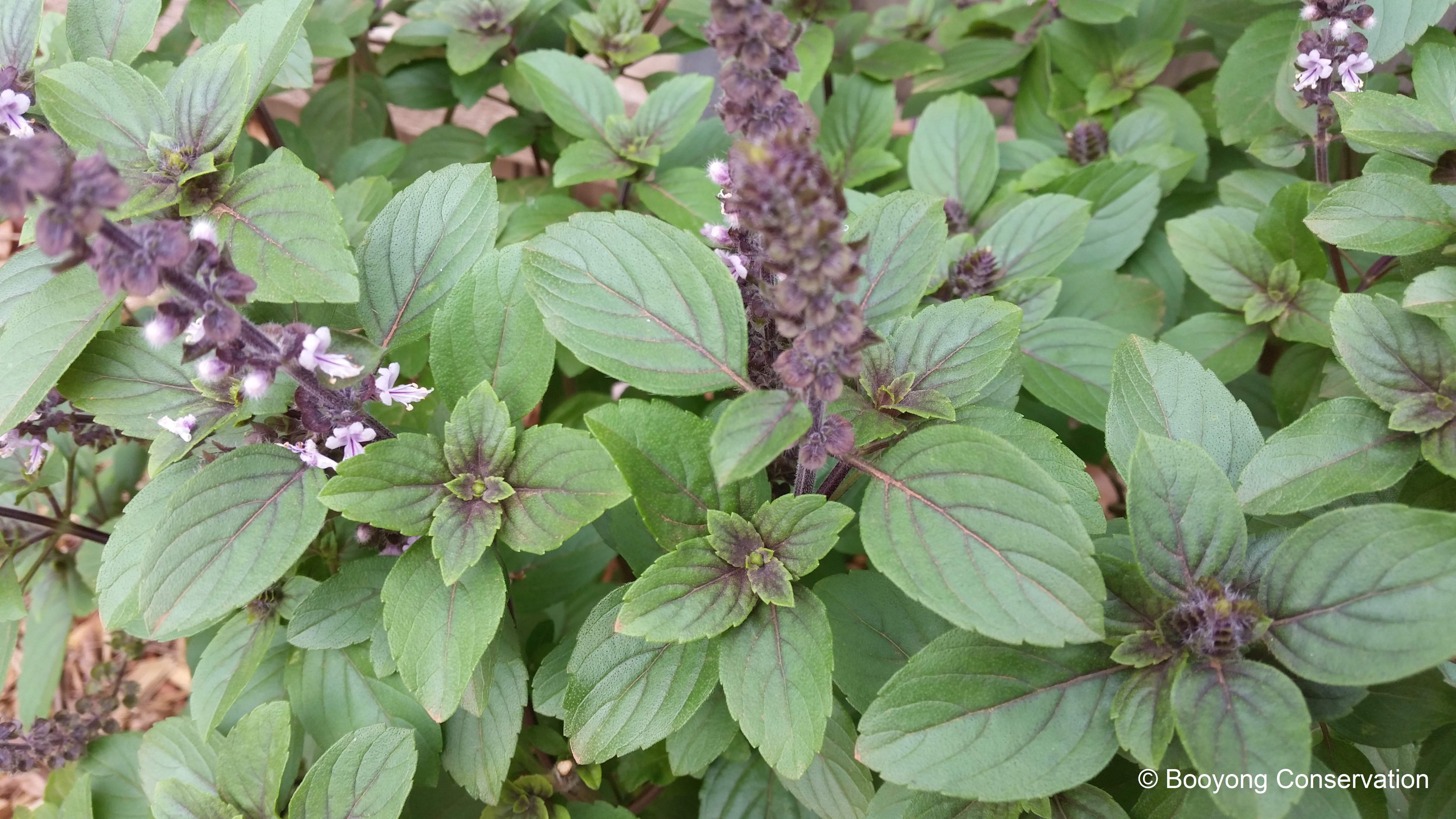Our lovely Sydney neighbour Mette gifted us an African Blue Basil plant (Ocimum kilimandscharicum x basilicum ‘Dark Opal’), a strong fragrant perennial green and purple herb that grows 80-100cm high, flowers all year-round and will attract bees to your garden.
How and where to Grow: This is a hardy plant that loves full sun and can be planted in either a large pot or in your garden. It likes fertile soil with mulch and will benefit from regular applications of organic fertiliser.
Care and Maintenance: The African blue basil is tolerant of light frost and will develop a woody stem over time. It can be pruned in Autumn and Spring and I prune mine heavily (2/3rds) and quite often, ensuring I leave some stems with flowers for the bees. It has a life span of about 5 years and cuttings can easily be propagated to ensure you have a lifelong supply.
Companion Planting: This herb has lovely 6-inch-long stalks of flowers that attract both native and European honeybees and flowers all year long. The cut flower stalks also look lovely in a vase and are plentiful.
Perennial basils, repel aphids, asparagus beetles, flies, mites, making them good companion plants for veggies like tomatoes, beans, and sweet peppers, as well as for fruit trees. The leaves produce a strong scent and make a wonderful natural insect spray, driving away aphids, mites and bugs. To displace ants, add vinegar to the tea and pour the mixture down ant holes or in-between pavers.
Propagation: We have been curious to find that the African Blue basil doesn’t produce seeds. It is a hybrid and is best propagated by cuttings. We propagated our in December by placing cuttings in a glass of water on the window, we left them for several days until roots emerged and then placed them in a seedling mix.
Pest and Diseases: Basil is generally disease-free. The pests that attack basil include aphids, flea beetles, Japanese beetles, snails and slugs. Aphids excrete honeydew, and sooty mold grows on the substance. Cut off mouldy leaves and knock aphids off of plants with a hose.
Harvest: Leaves can be harvested all year round and it helps to pinch the tips to encourage several sets to grow. The flowers and young stems are also edible.
Similarly, to other herbs you can cut and hang up a bunch of basil to dry and store in a sealed, clean, sterilized jar in your pantry for use.
Uses: The lovely coloured leaves are a beautiful addition to many dishes, so pretty! An infusion of leaves can also be added to your bathwat er to invigorate you – the smell is amazing!
er to invigorate you – the smell is amazing!
Health Benefit: Basil can be beneficial for toothache, colds, coughs, migraine, nose bleeds, fever, indigestion, diarrhoea and is described as being an effective mosquito repellent.
Recipes: The African Blue basil has a strong camphor flavour and can be used in all familiar basil recipes like pesto, salads, tomatoe dishes and soups. The stronger taste also makes it especially suitable for Thai cuisine. We also place fresh or torn leaves on tomatoe and bocconcini pizza which is delicious.
Pesto
Pesto is a staple in our fridge and homemade is the best, especially when you grow your own.
We first learnt to make pesto in Stephanie Alexanders book (The Cooks Companion), a wedding present from my housemate at the time Darren from Gershgoods.
• 1 cup basil leaves
• ½ cup extra virgin olive oil
• 30 gm pine nuts
• 2 cloves fresh crushed garlic
• Salt
• 60 gms grated parmesan cheese
Blend basil, oil, pine nuts, garlic, salt until smooth in a mortar and pestle or food processor. When blended, stir in parmesan cheese and store in a sealed glass jar covered with a film of oil (to stop from going brown) and placed in the fridge.
When using African Blue Basil we will often add some spinach leaves due to the strong camphor taste.
Basil Sugar Syrup
We use a 1:1 sugar to water ratio to make a rich syrup.
• Place one cup of water into a clean saucepan
• Add one cup of sugar into the water and place over a low heat
• Stir gently until the sugar is dissolved and simmer until you see the syrup change colour a little, you see a beautiful shimmer but be mindful not to let it turn into toffee.
• Add the leaves of basil, turn the heat off and leave the syrup to cool with the basil leaves in the pan
• Strain through a sieve and funnel and keep in a clean glass bottle in the fridge
• Lovely with cold soda water or a splash of vodka – so refreshing!

You must be logged in to post a comment.